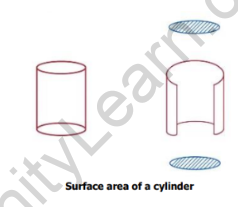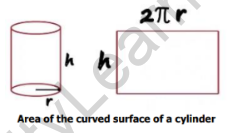Table of Contents
Introduction
Surface area refers to the total area that covers the outer surface of a three-dimensional object. It includes the sum of all the areas of the object’s individual faces or surfaces. Surface area is typically measured in square units, such as square centimeters or square meters. It is an important concept in geometry and is used to determine the amount of material required to cover or wrap an object, as well as in various calculations and formulas related to shapes and structures.
What is the surface area of a cylinder?
The total surface area of a cylinder is the sum of the areas of the circular ends and its curved surface.

Surface Area of a Cylinder Formula
If the plane circles in the bases of the cylinder are removed and the curved surface is
opened vertically, then it looks like a rectangle.
Thus, for a cylinder’s curved surface,
- The length of the rectangle is the circumference of the circular base
- The breadth of the rectangle is the height of the cylinder

For a cylinder with height h and radius of its base r,
Area of rectangular curved surface= 2πrh
Total surface area of a cylinder = Areas of the 2 circles + Area of rectangle
= πr2 + πr2 +2πrh
= 2πr2 +2πrh
= 2πr(r+h)
Therefore, the formula for total surface area of a cylinder is 2πr(r+h).
Also Check
Solved Examples on Surface Area of Cylinder
Example 1: Find the surface area of a cylinder with a radius of 4 cm and height of 10 cm.
Solution: Given: Radius (r) = 4 cm, Height (h) = 10 cm
Step 1: Calculate the lateral surface area
Lateral surface area = 2πrh
Lateral surface area = 2 x 3.14 x 4 x 10
Lateral surface area = 251.2 cm²
Step 2: Calculate the area of the two bases
Area of one base = πr²
Area of one base = 3.14 x 42
Area of one base = 50.24 cm²
Step 3: Calculate the total surface area
Total surface area = Lateral surface area + 2 x Area of one base
Total surface area = 251.2 + 2 x 50.24
Total surface area = 351.68 cm²
Therefore, the surface area of the cylinder is 351.68 cm².
Example 2: Find the surface area of a cylinder with a radius of 6.5 cm and height of 15 cm.
Solution: Given: Radius (r) = 6.5 cm, Height (h) = 15 cm
Step 1: Calculate the lateral surface area
Lateral surface area = 2πrh
Lateral surface area = 2 x 3.14 x 6.5 x 15
Lateral surface area = 615.6 cm²
Step 2: Calculate the area of the two bases
Area of one base = πr²
Area of one base = 3.14 x 6.52
Area of one base = 132.665 cm²
Step 3: Calculate the total surface area
Total surface area = Lateral surface area + 2 x Area of one base
Total surface area = 615.6 + 2 x 132.665
Total surface area = 881.93 cm²
Therefore, the surface area of the cylinder is 881.93 cm².
Frequently Asked Questions on Surface Area of Cylinder
What is the surface area of a cylinder?
The surface area of a cylinder is the total area of all its curved and flat surfaces. It includes the sum of the lateral surface area and the area of the two bases. The formula for the total surface area of a cylinder is 2πr(r+h).
How do you calculate the lateral surface area of a cylinder?
The lateral surface area of a cylinder is the surface area of its curved side, excluding the areas of the top and bottom circular bases. It is the measure of the area that wraps around the cylinders sides. It is calculated using the formula: Lateral Surface Area = 2πrh, where r represents the radius of the base and h represents the height of the cylinder.
What is CSA and TSA of cylinder?
CSA stands for Curved Surface Area, which refers to the surface area of the curved side of a three-dimensional object. In the context of a cylinder, the CSA is the same as the lateral surface area. Its formula is given by 2πrh. TSA stands for Total Surface Area, which refers to the sum of all the surface areas of a three-dimensional object. In the case of a cylinder, the TSA includes the lateral surface area (CSA) along with the areas of both circular bases. Its formula is given by 2πr(r+h).
Is CSA and LSA of cylinder same?
Yes, in the context of a cylinder, CSA and LSA refer to the same thing. Both terms represent the surface area of the curved side of the cylinder, excluding the areas of the circular bases. So, CSA and LSA are used interchangeably to describe the same surface area of the cylinder.
What are the two types of surface area of a cylinder?
The two types of surface area of a cylinder are: Lateral Surface Area: This is the surface area of the curved side of the cylinder. It is calculated by multiplying the height of the cylinder h by the circumference of the base 2πr, where r is the radius of the cylinder base. Total Surface Area (TSA): This is the sum of the lateral surface area (LSA) and the areas of the two circular bases of the cylinder. It is calculated by adding the LSA to twice the area of one base. The formula for TSA is TSA = LSA + 2πr², where r is the radius of the cylinder's base. So, the two types of surface area of a cylinder are the Lateral Surface Area (LSA) and the Total Surface Area (TSA).
How to Find the Surface Area of an Open Top Cylinder?
To find the surface area of an open top cylinder, you need to consider two components: the curved surface area (CSA) and the base area. Curved Surface Area (CSA): The curved surface area of a cylinder is calculated by multiplying the height (h) of the cylinder by the circumference of its base. The formula for CSA is CSA = 2πrh, where r is the radius of the base and h is the height of the cylinder. Base Area: The base area of a cylinder is the area of its circular base. The formula for the base area is A = πr2, where r is the radius of the base. To find the surface area of an open top cylinder, add the curved surface area and the base area together: Surface Area = CSA + Base Area.
What is the surface area of a cylinder without the top?
The surface area of a cylinder without the top, also known as the lateral surface area, can be calculated using the formula 2πrh, where π is the mathematical constant pi (approximately 3.14159), r is the radius of the cylinder's base, and h is the height of the cylinder. This formula accounts for the curved surface area of the cylinder while excluding the area of the top circular base.
What is the formula to find the base area of a cylinder?
The formula to find the base area of a cylinder is πr2, where π is the mathematical constant pi (approximately 3.14159) and r is the radius of the cylinder's base. By substituting the value of the radius into the formula, you can calculate the base area of the cylinder. The total base area of a cylinder will be πr2 + πr2







